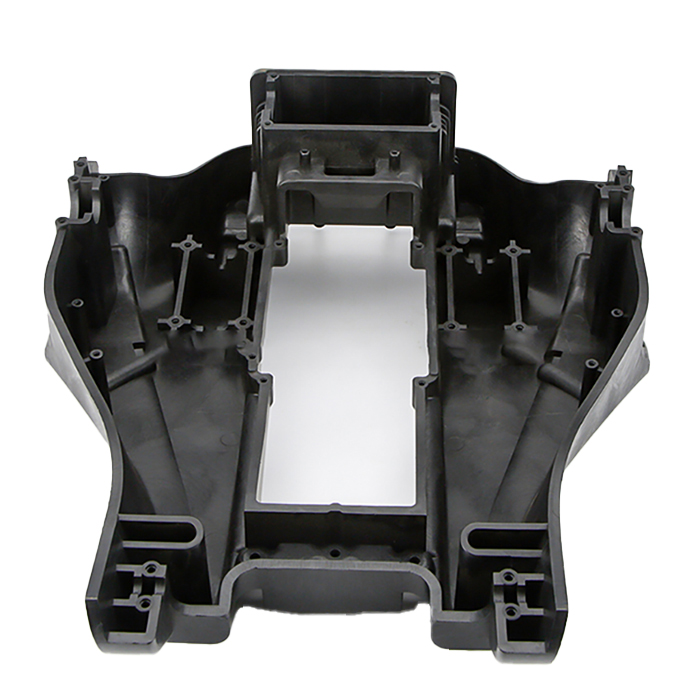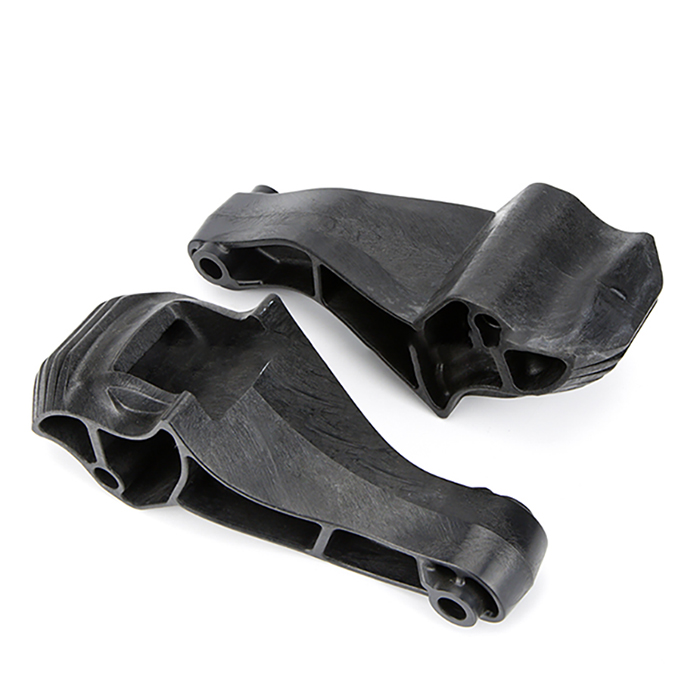What is Structural Foam Molding?
Structural foam is a low-pressure plastic injection molding process producing plastic parts and components that are lightweight and exceptionally strong. Rather than relying solely on machine pressure like the high-pressure/traditional process, this low-pressure technique introduces a chemical blowing agent into the plastic melt, which helps fill a mold. This blowing agent, along with the possible use of gas-assist, aids in the fill and pack-out of the mold.
The process produces a cellular ‘foam’ core with solid outer surfaces known as the skin. The unique properties of finished low-pressure molded material make it more rigid because of the solid outer skin. The cellular core adds to the strength and impact resistance. Plus, the density reduction of the core means parts are 10% to 15% lighter in weight compared to solid injection molded plastic.
Modern low-pressure injection technology is very advanced, and not all product designers and engineers are as familiar with the capabilities of this method as they are with conventional plastic injection molding. We created this guide to help demystify and explain the benefits of structural foam, with the goal of helping companies decide if this method of production is a good fit for their plastic products.
How Does the Low-pressure Structural Foam Injection Molding Process Work?
The process begins by mixing a melted plastic resin with a chemically inactive gas or foaming agent in the barrel of an injection molding machine.
The combined materials are then injected into the mold where the gas expands &‘packs out’ the mold cavity. This reaction allows for low-pressure injection to make larger parts on smaller machine tonnages without causing inherent stresses commonly found in high-pressure injection molding.
As the part cools, the foamed core, often referred to as a cellular core, begins to harden, creating a ridged center. The outer walls, sometimes called ‘skin’, produce a solid & smooth surface so that the inner core is not visible.
Once the structural foam part is completely cooled, the mold cavity & core separate to release a heavy-duty plastic part.


Applications of Low-pressure Structural Foam
The commercial applications of low-pressure foam molding are practically unlimited, with the process and material offering designers and engineers unique creative and functional properties.
The tough and lightweight plastic resulting from the structural foam process creates products perfect for use in recreational vehicles, commercial truck parts and products, outdoor consumer products, industrial and business equipment, underground applications, and much more.
Advantages of Structural Foam Molding
Structural foam revolutionized manufacturing by offering benefits previously unavailable in plastic manufacturing. While its impressive capacity to fabricate large components – think large panels or machine structural components – initially gained recognition, the true potential of this molding technique extends far beyond size alone. The sections below detail some of these benefits.
Perfect for large, heavier plastic parts
Low-pressure injection molding is particularly well-suited for projects involving heavy parts, ranging from 8 pounds to an impressive 400 pounds. The reputed robustness and load-bearing capabilities of parts produced via this process make it an excellent choice when dealing with plastic products that are large, have multiple parts, and/or need an improved cycle time from rotational molding, sheet metal, or vacuum-formed processes.
Durable and strong components
Compared to other manufacturing processes, this plastic molding technique offers an exceptional strength-to-weight ratio and superior impact resistance with weight reduction up to 15% (by volume) compared to standard injection molding. These qualities provide a distinct advantage, ensuring your products are not only robust but also lightweight and impervious to the elements, enhancing overall performance and customer satisfaction.
Accommodates intricate, complex designs
When your design demands intricate features that surpass the capabilities of processes like vacuum forming, rotational molding, machining, or blow molding, low-pressure molding rises to the challenge. It allows for greater complexity and versatility in design, accommodating the diverse requirements of your products while decreasing the visibility of sink or read-through from thick sections or ribs.
Color control and consistency
Offering a complete range of colors, the low-pressure injection process allows for color consistency across products during production. Two colors can even be molded simultaneously – as well as two different materials – for the ultimate in creative freedom with respect to product design. Also, the consistent surface finish of plastic parts produced via this process is hard to beat. Note – this production technique can create a swirling or “silvering” effect that may not be ideal for certain products. For methods to eliminate this effect, please see our gas-assist molding page.
Efficient, cost-effective production
The low-pressure injection process provides cost-effective solutions by utilizing smaller machines to mold larger parts, reducing manufacturing expenses. Furthermore, compatibility with aluminum molds presents additional benefits, as aluminum molds require minimal maintenance when constructed correctly and maintained properly, resulting in extended tool life that can surpass that of steel molds. Structural foam molding also optimizes material usage for larger parts, allowing you to achieve efficiency and sustainability goals while maintaining product quality.
Dimensional accuracy
For industries that prioritize dimensional accuracy and reliability across large-scale production, structural foam excels. It ensures consistent dimensional precision, allowing for repeatable results across thousands of parts.
Enhances your competitive edge
Low-pressure foam techniques typically require no post-mold machining, resulting in faster cycle times and reducing costs. This molding process significantly reduces barriers to entry for large-scale production by lowering the capital requirements for tooling when compared with steel mold costs.
By leveraging the foam molding process, you gain access to a wide range of advantages that enhance the manufacturing process and the performance of your products. From versatility in assembly creation to durability against elements, handling heavyweights, and meeting design complexities, low-pressure molding proves its worth. It ensures dimensional reliability, superior strength-to-weight ratio, impact resistance, cost efficiency, and extended tool life. Embrace the benefits of low-pressure injection molding to elevate your manufacturing capabilities and create high-quality products.
Is Low-pressure Structural Foam the Solution for You?
The low-pressure molding process creates strong, high-quality plastic components efficiently and cost-effectively – but is it right for your product?
Structural foam molding…
- allows for thicker wall sections compared to high-pressure injection molding. It is recommended to not have wall sections thicker than .250”
- creates a ‘swirling’ or ‘silvering’ effect on parts
- uses aluminum tooling
- is a good candidate for large parts or multiple parts manufactured via injection molding, blow molding, roto molding, vacuum forming, thermoforming, wood, concrete, fiberglass, or sheet metal.
- is best utilized with cycle times of around two to three minutes.
- allows for multiple parts in an assembly to be made in one mold or machine at once, eliminating separate assembled parts/kits to be finalized in a separate factory location (especially multi-nozzle molding).




What’s the process for starting work with a low-pressure foam molder?
1.A 3D CAD model will need to be made for your part(s). If you don’t have one yet that’s no problem, we might be able to help.
2.Identify the project scope requirements like:
- What material to use for the parts
- Color & finish options
- Project timeline
- Number of pieces needed annually
- Secondary operations that may be needed
- Packaging requirements
3.Using the project scope, submit your file to understand what the mold & parts will cost in production
4.If you’d like to proceed, submit your initial payment for tooling.
5.Once the tool builder is involved, your project design will get a thorough review for possible design changes that may be needed as the tool is designed.
6.Once the mold build is complete, we can start molding parts.
Don’t worry if you don’t have all the answers to the items above, contact us today and we can help talk about it further.
Case of Pressure Die Casting









Ready to Work On your Next Project?
Let us help you provide high quality parts in short time. Get your project started now!